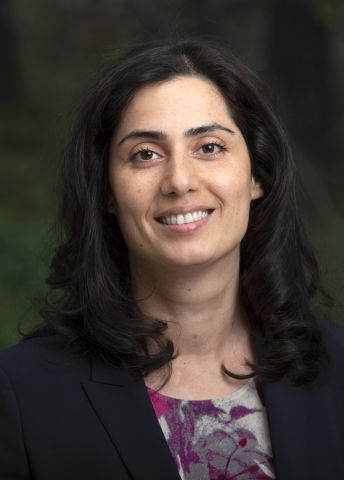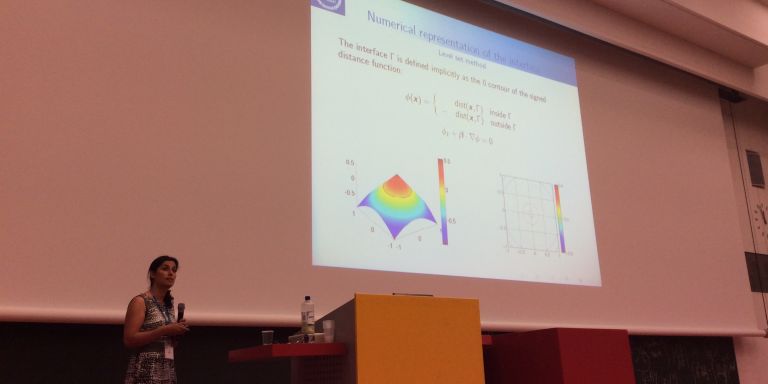
Sara Zahedi
Associate Professor of Mathematics
Wallenberg Academy Fellow, Prolongation grant 2024
Institution:
KTH Royal Institute of Technology
Research field:
Numerical analysis


Wallenberg Academy Fellow, Prolongation grant 2024
Institution:
KTH Royal Institute of Technology
Research field:
Numerical analysis
Conducting scientific experiments is often costly and time-consuming – sometimes even impossible. So it is extremely valuable to be able to simulate real phenomena and processes on computers. These days, computer simulations are used in many areas – for example when developing new vehicles with optimal aerodynamics, making climate forecasts, or exploring biological processes at molecular level.
“It’s really gratifying to develop numerical algorithms for computer simulations because they can often be used in a wide variety of interesting applications. We contribute with tools that can be used by many people,” says Zahedi, who researches in numerical analysis at KTH Royal Institute of Technology.
In particular, she is developing algorithms to simulate phenomena involving moving objects with deformable shapes, such as the interface between immiscible fluids, heart valves or melting ice floes at sea.
The simulations are based on equations describing how the pressure and velocity are related when surface tension and other forces affect objects. These are partial differential equations, whose explicit solutions are often unknown.
“We solve them numerically instead, by finding approximations with the help of a computer.”
One well-established method for solving partial differential equations numerically is the finite element method, which uses a grid to subdivide a complicated domain into smaller, simpler parts.
“The method works well for problems involving objects with complex geometries. But it requires that the grid be well adapted to the geometry. If the objects move, or their geometry changes, the gridding has to be redone, which is troublesome, and requires a lot of computing power,” Zahedi explains.
For this reason she has developed and verified an alternative method, in which the shapes of the objects are allowed to cut through a grid generated completely independently of the shape of the objects. It is called the cut finite element method, or CutFEM for short, and has improved the scope for simulation of changing structures.
This work was one of the reasons that Zahedi was awarded the European Mathematical Society Prize in 2016.
“At the time I never realized how important the prize was, but it has opened many doors. I’ve been invited to many places around the world to present my research, and I’ve met many great researchers, which has helped me to grow.”
As far as she can recall, she has always liked mathematics. One reason may be that she arrived in Sweden unaccompanied as a refugee from Iran when she was nine years old. She moved in with a family she did not know and started Swedish school, where she did not understand anything to start with – except in the math lessons.
“In those lessons I could do the exercises at least as well as the other children, and we could solve problems together using the common language of mathematics.”
Mathematics continued to be the subject she enjoyed most, and having studied theoretical mathematics, she eventually came into contact with numerical analysis – a research field that combines programming, mathematics, and applications.”
“I found it challenging – it spurred me on.”
Zahedi will use the Wallenberg Academy Fellow grant to further develop her numerical methods for evolving geometries. She wants to scale up from detailed computations involving three or four moving objects to situations with thousands of objects. She also wants to ensure that key physical properties are retained by the computations.
The application on which her research is focused uses microbubbles to transport drugs around the body. When they reach their destination – a tumor for example –ultrasound is used to release the drug.
“It’s an interesting example, and presents challenges that our algorithms need to be able to cope with.”
The microbubbles interact with each other to a great extent, and it is hoped that simulations will answer questions about the optimal number and size of the bubbles, how they should be stabilized to not burst during their journey, and how they can be burst using ultrasound.
“The project entails numerous difficult challenges. As soon as more than three or four objects are involved, a lot of computing power is needed.”
“The Academy Fellow grant has given me much more time for research, and I can carry out a project involving greater risks than usual. This makes me more creative.”
Zahedi’s plan is to first continue working on her existing numerical algorithms until she can ensure they are really good at simulating a limited number of moving objects. Then, using the simulations as learning materials, computers with self-learning algorithms for deep learning will help to work out how the method can be scaled up to thousands of objects.
“If we succeed, we’ll open the door for accurate simulations of many real-world applications, not only microbubbles.”
Text Ingela Roos
Translation Maxwell Arding
Photo Emanuel Rubensson, Laurence Halpern, Marcus Marcetic